Variability of the relationship between electrophysiology and BOLD-fMRI across cortical regions in humans
- PMID: 21900564
- PMCID: PMC3322193
- DOI: 10.1523/JNEUROSCI.1457-11.2011
Variability of the relationship between electrophysiology and BOLD-fMRI across cortical regions in humans
Abstract
The relationship between blood oxygenation level-dependent (BOLD) functional MRI (fMRI) signal and the underlying neural electrical activity in humans is a topic of intense interest to systems neuroscience. This relationship has generally been assumed to be invariant regardless of the brain region and the cognitive task being studied. We critically evaluated these assumptions by comparing the BOLD-fMRI response with local field potential (LFP) measurements during visually cued common noun and verb generation in 11 humans in whom 1210 subdural electrodes were implanted. As expected, power in the mid-gamma band (60-120 Hz) correlated positively (r(2) = 0.16, p < 10(-16)) and power in the beta band (13-30 Hz) correlated negatively (r(2) = 0.09, p < 10(-16)) with the BOLD signal change. Beta and mid-gamma band activity independently explain different components of the observed BOLD signal. Importantly, we found that the location (i.e., lobe) of the recording site modulates the relationship between the electrocorticographic (ECoG) signal and the observed fMRI response (p < 10(-16), F(21,1830) = 52.7), while the type of language task does not. Across all brain regions, ECoG activity in the gamma and beta bands explains 22% of the fMRI response, but if the lobar location is considered, 28% of the variance can be explained. Further evaluation of this relationship at the level of individual gyri provides additional evidence of differences in the BOLD-LFP relationship by cortical locus. This spatial variability in the relationship between the fMRI signal and neural activity carries implications for modeling of the hemodynamic response function, an essential step for interregional fMRI comparisons.
Figures

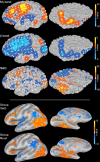
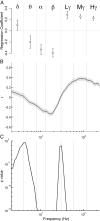
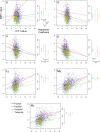
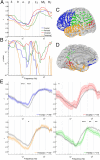
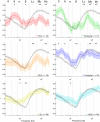


Similar articles
-
Frequency-specific electrocorticographic correlates of working memory delay period fMRI activity.Neuroimage. 2011 Jun 1;56(3):1773-82. doi: 10.1016/j.neuroimage.2011.02.062. Epub 2011 Feb 26. Neuroimage. 2011. PMID: 21356314 Free PMC article.
-
Methods for determining frequency- and region-dependent relationships between estimated LFPs and BOLD responses in humans.J Neurophysiol. 2009 Jan;101(1):491-502. doi: 10.1152/jn.90335.2008. Epub 2008 Nov 12. J Neurophysiol. 2009. PMID: 19005004
-
The fMRI BOLD signal tracks electrophysiological spectral perturbations, not event-related potentials.Neuroimage. 2012 Feb 1;59(3):2600-6. doi: 10.1016/j.neuroimage.2011.08.079. Epub 2011 Sep 8. Neuroimage. 2012. PMID: 21925278 Free PMC article.
-
On the relationship between slow cortical potentials and BOLD signal changes in humans.Int J Psychophysiol. 2008 Mar;67(3):252-61. doi: 10.1016/j.ijpsycho.2007.05.018. Epub 2007 Jul 12. Int J Psychophysiol. 2008. PMID: 17669531 Review.
-
Lessons from fMRI about mapping cortical columns.Neuroscientist. 2008 Jun;14(3):287-99. doi: 10.1177/1073858407309541. Epub 2007 Nov 7. Neuroscientist. 2008. PMID: 17989170 Free PMC article. Review.
Cited by
-
Direct physiologic evidence of a heteromodal convergence region for proper naming in human left anterior temporal lobe.J Neurosci. 2015 Jan 28;35(4):1513-20. doi: 10.1523/JNEUROSCI.3387-14.2015. J Neurosci. 2015. PMID: 25632128 Free PMC article.
-
Efficient "pop-out" visual search elicits sustained broadband γ activity in the dorsal attention network.J Neurosci. 2012 Mar 7;32(10):3414-21. doi: 10.1523/JNEUROSCI.6048-11.2012. J Neurosci. 2012. PMID: 22399764 Free PMC article. Clinical Trial.
-
Beta modulation reflects name retrieval in the human anterior temporal lobe: an intracranial recording study.J Neurophysiol. 2016 Jun 1;115(6):3052-61. doi: 10.1152/jn.00012.2016. Epub 2016 Apr 13. J Neurophysiol. 2016. PMID: 27075536 Free PMC article.
-
Neural Electrical Correlates of Subjective Happiness.Hum Brain Mapp. 2025 Jun 1;46(8):e70224. doi: 10.1002/hbm.70224. Hum Brain Mapp. 2025. PMID: 40421899 Free PMC article.
-
Intracranial electroencephalography reveals different temporal profiles for dorsal- and ventro-lateral prefrontal cortex in preparing to stop action.Cereb Cortex. 2013 Oct;23(10):2479-88. doi: 10.1093/cercor/bhs245. Epub 2012 Aug 9. Cereb Cortex. 2013. PMID: 22879352 Free PMC article.
References
-
- Bruns A. Fourier-, Hilbert- and wavelet-based signal analysis: are they really different approaches? J Neurosci Methods. 2004;137:321–332. - PubMed
-
- Cohen J, Cohen P. Ed 2. Hillsdale, NJ: Lawrence Erlbaum; 1983. Applied multiple regression/correlation analysis for the behavioral sciences.
Publication types
MeSH terms
Substances
Grants and funding
LinkOut - more resources
Full Text Sources
Research Materials
